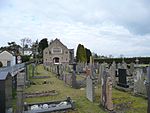Iscoed
Country houses in CarmarthenshireGrade II listed buildings in CarmarthenshireMansel family

Iscoed, Ferryside, Carmarthenshire, Wales is a ruined eighteenth century mansion attributed to the architect Anthony Keck. Constructed for Sir William Mansel in 1772, it was purchased by the Napoleonic general Sir Thomas Picton as an incomplete shell in 1812. The house remained the property of the Picton family until the end of the First World War. Used subsequently as council housing, it has been empty since the 1950s, and is now a derelict shell. The house is Grade II listed.
Excerpt from the Wikipedia article Iscoed (License: CC BY-SA 3.0, Authors, Images).Iscoed
Geographical coordinates (GPS) Address Nearby Places Show on map
Geographical coordinates (GPS)
| Latitude | Longitude |
|---|---|
| N 51.7812 ° | E -4.3451 ° |
Address
SA17 5TP , Llandyfaelog
Wales, United Kingdom
Open on Google Maps








